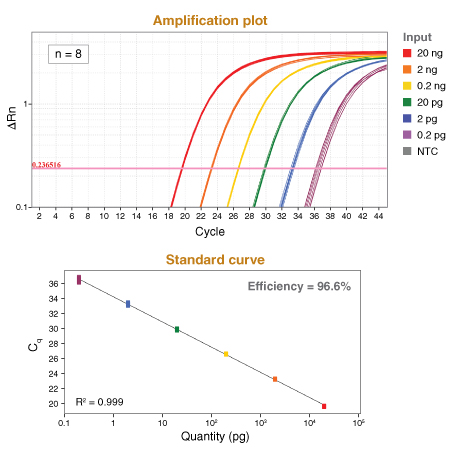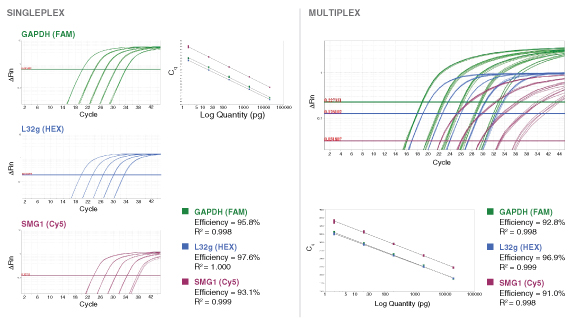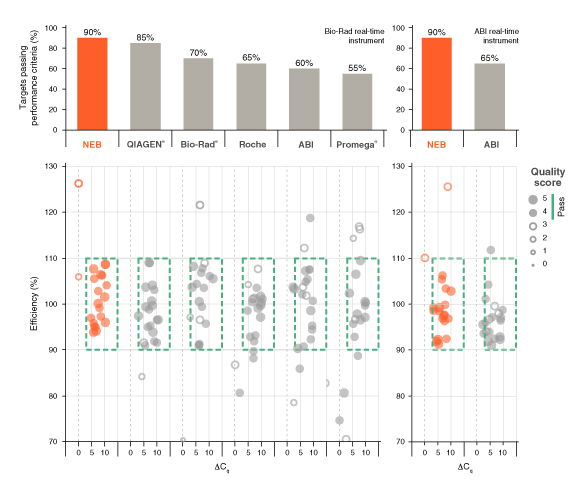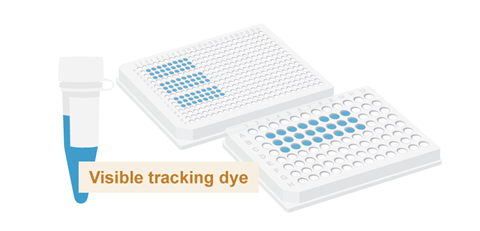Rapid, sensitive and precise probe-based qPCR detection and quantitation of target DNA and cDNA sequences.
Make a simpler choice
Experience best-in-class performance
Probe-based quantitative PCR (qPCR) uses real-time fluorescence released upon 5´→3´ exonuclease cleavage of a quenched, target-specific probe to measure DNA amplification at each cycle of a PCR. At a point where the fluorescence signal is significantly detectable over the background fluorescence, a quantification cycle or Cq value can be determined. Cq values can be used to evaluate relative target abundance between two or more samples or to calculate absolute target quantities in reference to an appropriate standard curve, derived from a series of known dilutions.
The Luna Universal Probe qPCR Master Mix is a 2X reaction mix optimized for real-time qPCR detection and quantitation of target DNA sequences using hydrolysis probes. It contains Hot Start Taq DNA Polymerase and has been formulated with a unique passive reference dye that is compatible across a variety of instrument platforms (including those that require a high or low ROX reference signal). It also features dUTP for carryover prevention and a non-fluorescent, visible dye to monitor reaction setup. This dye does not spectrally overlap fluorophores commonly used for qPCR and will not interfere with real-time detection.
The master mix formulation is supplied at 2X concentration and contains all PCR components required for amplification and quantitation of DNA except primers/probes and DNA template. Genomic DNA or cDNA of interest can be quantitated with Luna qPCR and existing as well as commercial qPCR assay primer/probe sequences can be used.




The following reagents are supplied with this product:
| NEB # | Component Name | Component # | Stored at (°C) | Amount | Concentration |
Some real-time instruments recommend the use of a passive reference dye (typically ROX) to overcome well-to-well variations that could be caused by machine limitations such as “edge effect”, bubbles, small differences in volume, and autofluorescence from dust or particulates in the reaction. However, ROX normalization does little to the variations caused by pipetting errors of templates/primers, heterogeneous mixing, and evaporation/condensation issues.
A universal passive reference dye is included in the following Luna® qPCR products: Luna Universal qPCR Master Mix (NEB #M3003), Luna Universal Probe qPCR Master Mix (NEB #M3004), Luna Universal One-Step RT-qPCR Kit (NEB #E3005), and Luna Universal Probe One-Step RT-qPCR Kit (NEB #E3006). These products support broad instrument compatibility (High-ROX, Low-ROX, ROX-independent) so no additional ROX is required for normalization.
The Luna Probe One-Step RT-qPCR Kit (No ROX) (E3007) contains no reference dye and is compatible with any instrument that does not require ROX. If ROX normalization is needed, ROX can be added. Please refer to instrument manufacturer’s instructions for greater details.
Products and content are covered by one or more patents, trademarks and/or copyrights owned or controlled by New England Biolabs, Inc (NEB). The use of trademark symbols does not necessarily indicate that the name is trademarked in the country where it is being read; it indicates where the content was originally developed. The use of this product may require the buyer to obtain additional third-party intellectual property rights for certain applications. For more information, please email busdev@neb.com.
This product is intended for research purposes only. This product is not intended to be used for therapeutic or diagnostic purposes in humans or animals.
New England Biolabs (NEB) is committed to practicing ethical science – we believe it is our job as researchers to ask the important questions that when answered will help preserve our quality of life and the world that we live in. However, this research should always be done in safe and ethical manner. Learn more.Nucleic acid-based aptamers for use with thermophilic DNA polymerases are licensed exclusively by New England Biolabs, Inc. from SomaLogic, Inc. New England Biolabs, Inc. gives the Buyer/User a non-exclusive license to use the Luna Universal Probe qPCR Master Mix for Research Use Only (RUO). Commercial use of this product may require a license from New England Biolabs, Inc. For additional information or to inquire about commercial use, please contact busdev@neb.com. BIO-RAD® is a registered trademark of Bio-Rad Laboratories.
FASTSTART™ is a trademark of Roche.
GOTAQ® and PROMEGA® are registered trademarks of Promega Corporation.
QIAGEN® and QUANTITECT® are registered trademarks of Qiagen, Inc.
QUANTSTUDIO® is a registered trademark of Life Technologies Corporation.
SOMAMER® is a registered trademark of Somalogic, Inc.
SSOADVANCED™ is a trademark of Bio-Rad Laboratories.
STEPONE® is a registered trademark of Applied Biosystems, LLC.
SYBR® is a registered trademark of Molecular Probes, Inc.
TAQMAN® is a registered trademark of Thermo Fisher Scientific.